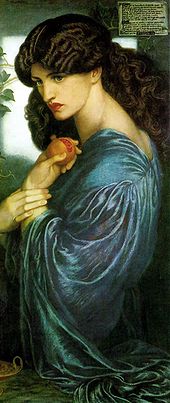Proserpine




Proserpina is a Roman deity. She is the daughter of Jupiter and Ceres and wife of Pluto , who kidnapped her into the underworld and made her his wife. She is the ruler of the dead and queen of the underworld. It corresponds to Persephone in Greek mythology .
In the case of Varro , the name is derived from proserpere (“creep out”, “snake out”), referring to the grain germ creeping out of the (underworld of) earth .
myth
Pluto asked Jupiter for the hand of Proserpine, but Jupiter said that her mother Ceres would never allow her daughter to live in gloomy Tartaros, but gave him the freedom to kidnap her, which Pluto then did. On a meadow on the slopes of Mount Etna, where Proserpina was picking flowers, Pluto appeared with his chariot pulled by four black horses and dragged the struggling Proserpina down into the underworld. The inconsolable mother finally forced Jupiter to agree that Proserpina only had to spend half of the year in the underworld.
The mythology of Proserpine corresponds to the mythology of Persephone; it is probably a very extensive takeover of the Eleusinian deity by the Romans, linked with the popularization of the Eleusinian mysteries in the Roman Empire from the 1st century BC. As a result of the destruction of the sanctuary of Eleusis by Alaric I in 395/396, the late antique poet Claudian could have been inspired to write an epic about the "Rape of Proserpina" (De raptu Proserpinae) , which the founding myth of Eleusis treated.
cult
The robbery of Proserpina appears in the grave sculpture and tomb painting from around 100. The facial features of the female dead were matched to those of Proserpina who had been abducted into the underworld, as in the case of the Vibia grave , where the identification is also made clear in the inscription: abreptio Vibies et discensio (“The robbery and disappearance of Vibia”).
The Proserpina sarcophagus , in which Charlemagne may have been buried, is located in the cathedral treasury of Aachen Cathedral .
From the 1st century BC The use of the name Proserpine is documented in escape texts. In the provinces of the Roman Empire the cult of Proserpine is documented in many cases from votive inscriptions, especially in Spain and the Danube provinces. Shrines and cult images are attested in Vibo Valentia and on Malta .
literature
- Herbert Anton : The Rape of Proserpine. Literary traditions of an erotic emblem and mythical symbol . Winter, Heidelberg 1967.
- Christiane Brehm: The Rape of Proserpine. Studies on the iconography and iconology of an Ovid myth from antiquity to the early modern period. Dissertation. Münster (Westf.) 1996 Online (PDF).
- Jesse Benedict Carter : Proserpine . In: Wilhelm Heinrich Roscher (Hrsg.): Detailed lexicon of Greek and Roman mythology . Volume 3.2, Leipzig 1909, Col. 3141-3149 ( digitized version ).
- Mareile Haase: Proserpina. In: The New Pauly (DNP). Volume 10, Metzler, Stuttgart 2001, ISBN 3-476-01480-0 , column 439 f.
- Gerhard Radke : Proserpina. In: Paulys Realencyclopadie der classischen Antiquity Science (RE). Supplementary Volume IX, Stuttgart 1962, Sp. 1283-1287.
- Anselm Weyer: Die and become in Goethe's Proserpina. In: Arcadia - Internationale Zeitschrift für Literaturwissenschaft / International Journal for Literary Studies , Volume 46, Issue 1, 2011, pp. 27–42.
Web links
- Claudian De raptu Proserpinae ("The Rape of Proserpina"), Latin and English , edition of the Loeb Classical Library on LacusCurtius
Individual evidence
- ↑ Marcus Tullius Cicero: de natura deorum 2.66
- ^ Marcus Terentius Varro: de lingua Latina 5.68; antiquitates rerum humanarum et divinarum fr. 28, 167, 268 Cardauns
- ^ Hyginus Mythographus: fabulae 146
- ^ Fresco from the hypogeum of Vibia, Via Appia Antica , Rome. See also: Robin Margaret Jensen: Understanding early Christian art. 2000, p. 55
- ↑ CIL I 2520
- ↑ CIL II 143-145, 461, 462, 1044
- ↑ CIL III 5796, 7656, 11923, 12646
- ↑ CIL X 39, 7494